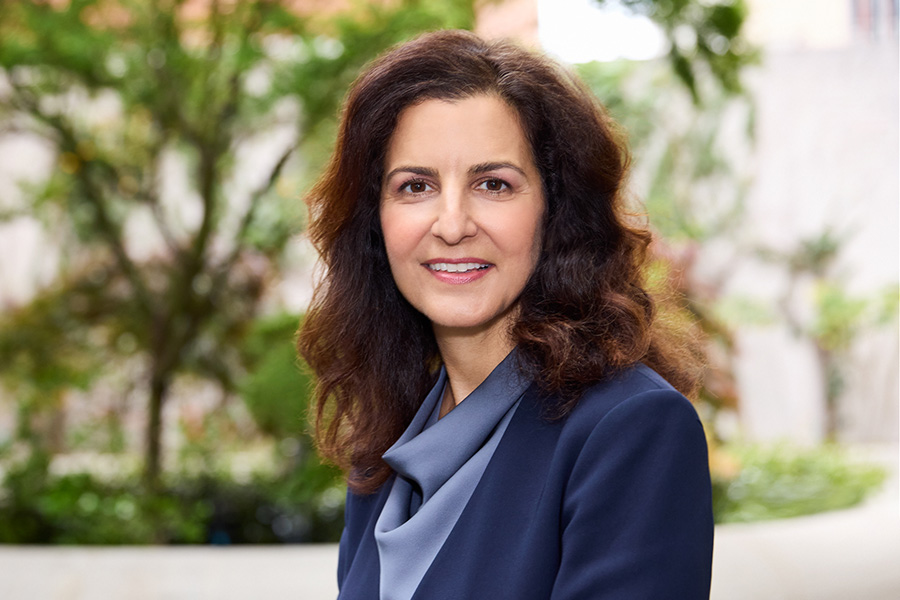August 5, 2023
Cardiologist Maria Ansari, MD, is the first woman to lead two of the nation’s largest physician groups.
As CEO and executive director of The Permanente Medical Group and CEO of the Mid-Atlantic Permanente Medical Group, she will lead 11,187 physicians and a staff of 44,000 who provide care for 5.4 million Kaiser Permanente members in Northern California, Maryland, Virginia and Washington, D.C.
Dr. Ansari is also co-CEO of The Permanente Federation, the national leadership and consulting organization for the eight Permanente Medical Groups.
Several Permanente medical groups are members of the AMA Health System Program, which provides enterprise solutions to equip leadership, physicians and care teams with resources to help drive the future of medicine.
Since 2014, Dr. Ansari had been the physician-in-chief and chief of staff at Kaiser Permanente San Francisco Medical Center. Her biography page on the Kaiser Permanente website credits Dr. Ansari for building that institution’s “culture of trust, innovation and teamwork” between primary care and specialty physicians.
The daughter of a cardiac surgeon who she accompanied on international medical missions, Dr. Ansari became chief of cardiology at the hospital in 2007.
She also served as the chief medical office liaison to the San Francisco Department of Public Health COVID-19 Vaccine Task Force and medical director of the Moscone Mass Vaccine Hub, the largest COVID-vaccine distribution center in California in 2021.
Dr. Ansari recently spoke with the AMA about her work, the importance of prevention in maintaining patients’ health and the significant role physician-led value-based care can play in that process.
AMA: You have said that one of your core beliefs is that physician leadership drives exceptional care for patients. Please explain the importance of physician leadership at the system, institution and local practice level.
Dr. Ansari: The entire Kaiser Permanente model of care is driven from physician leadership. Our model of care was developed by Dr. Sidney Garfield more than 75 years ago and was at the time considered an innovation or revolution in health care—where he was seeing patients and treating them at a hospital in the California Desert that he ran for people who were working on a Colorado River aqueduct.
Care at that time was being provided in a transactional way: You get sick. You come in and you receive care. There’s a fee, you pay for it, then you go home, and you come back when you’re sick again. He saw that that system wasn’t working.
To prevent injuries on the job, or to treat things like hypertension proactively, a pre-paid model of care brought the best value and the best outcomes.
So, he could focus on prevention, patient premiums were paid upfront. I think it was a nickel a day. Then he would invest in the person’s health like providing tetanus shots, so if they stepped on a nail, he wouldn’t be treating the ravages of disease.
So, it was value-based care—which is becoming the system everyone is trying to emulate right now.
Then we partnered with Kaiser health insurance so that we have an integrated-care platform, which is again, what we’re seeing happening across the country.
With our 75-year history, this is an area where we’ve developed a lot of expertise.
At the institutional level, you have physician leaders, with their training and experience, who are uniquely qualified to identify and address barriers or frustrations that other physicians are facing in caring for patients.
They’re able to drive the changes and the quality-improvement projects that lead to improved outcomes because they have credibility and the peer-to-peer ability to influence that.
At the practice level, when you have physician leadership and in a multispecialty group practice, the physicians are not your competition. They’re your peer advisers; you’re learning from one another.
AMA: What is your philosophy on the importance of prevention?
Dr. Ansari: I did my fellowship training at University of California, San Francisco [UCSF], for cardiology in the early 2000s and I used to do a lot of heart-disease outcomes research at Kaiser Permanente—which is not unusual because it’s where a lot of the patients are.
But I saw that, if you were a Kaiser Permanente member living in Northern California, you were 30% less likely to die of heart disease or stroke than if you were a nonmember. When I saw those results, I was super impressed, and jumped ship from UCSF to Kaiser Permanente in 2004.
And those outcomes weren’t because of the cardiologists. That’s the whole thing about prevention.
It starts with the basics in primary care. If you want to prevent heart disease, you need to start with risk-factor modification such as lifestyle change, blood-pressure and diabetes control, nutrition guidance and stress reduction. This whole multidisciplinary, wraparound service works in a model focused on prevention.
As a cardiologist, let’s say my patient comes to me and says, “My dad had a heart attack when he was 50, and I want to prevent that because I’m 46.”
If that patient never has a stroke, never has a heart attack, never needs open-heart surgery, that’s the most-desired outcome for that patient—and, it’s the most desired outcome for my practice.
But in a usual health care setting, it’s more transactional. For a cardiologist in a fee-for-service transactional world, if that patient doesn’t have a heart attack or need a stent, it’s hard to make money.
You don’t make money on prevention, it’s not well reimbursed. But, in a preventive model, you can. It helps when the system supports the work, because then I can focus on prevention and we have things such as grocery-shopping tours (to help patients make healthy choices), meditation classes and coaching on quitting tobacco.
AMA: What influenced you to become a cardiologist? How would you describe your relationships with your patients’ primary care physicians?
Dr. Ansari: I’ll start by talking about what influenced me to become a physician and then by extension, a cardiologist.
My father was a cardiac surgeon, and he used to do a lot of medical missions where he would go around the world to places where they didn’t have access to health care—particularly the mountain region in northwestern Iran where he’s from originally.
We would go off-roading to these small villages, and he would set up a tent and people would hear: “Oh, there’s this doctor here from America.”
And we’d wake up the next morning—having not seen a soul for the whole drive—and there’d be 200 people lined up outside our tent, waiting to see the doctor from America.
It was very impactful for me. I was just a teenager, and I went multiple times with him. I saw this kind of universal language of what medicine means to people and having someone touch what hurts or listen to their story to help them solve their health issue. I was struck by the connection and humanity of medicine.
I got into cardiology because the heart is such a fascinating, vital organ. It has a motor, valves, plumbing, electricity and it’s essential for human life. I’m fascinated by all components of it.
And cardiovascular disease is the No. 1 cause of death in this country, so it just seemed like a vital place to focus.
And, when you take care of someone’s heart, it really does take a team. Working with primary care is a big part of it. Because as I mentioned, prevention starts in primary care with risk-factor management.
When we care for a patient with congestive heart failure, there’s a lot of nutrition education, pharmacy and social-work support in terms of caring for yourself and maybe mental health support.
Building and fostering that trust and that collaboration is being really clear on what is the goal we’re trying to accomplish as a team and what does each individual has to contribute to getting to that goal.
I always say, “goals and roles.” What’s the goal, and what’s your role in contributing to that goal?
If everyone knows how they positively contribute to that outcome and everyone feels acknowledged and supported to do their best work, that’s how you get the collective best of a team.
AMA: What are the most important historical and social aspects of your being the first woman to lead The Permanente Medical Group? How will you use your position to promote workforce and leadership diversity?
Dr. Ansari: I’m very proud to be the first female CEO in our group. I hope that it inspires more women to lead, and I think it’s important for all of us—when we look at our executive teams and our boards—to look at who’s not at the table.
We know that diversity at the highest levels fosters diversity throughout the organization and also leads to a higher-performing and engaged team.
For myself, working to support and promote women physicians is important because it brings more women up into the leadership ranks, Also, and a lot of studies support this, women in leadership tend to be more interested and focused on the organizational good, more collaborative, more empathetic.
We know that empathetic leadership styles lead to a more engaged workforce and a more engaged workforce is more productive—and that’s great for the business side of medicine. I’m hoping that my leadership will do the same, and also bring a sense of optimism and willingness to listen to create more positive change.
Diversity of all kinds in leadership is important to inspire and to reflect your workforce—but also, in health care—to reflect patients. When you have a diverse workforce caring for a diverse patient population, you have improved health equity. That’s because there’s data that race concordance with the physician and patient improves outcomes.
Diversity of all kinds is super important. We’ve always been focused on health equity in The Permanente Medical Group since our very beginning. By working in a culturally responsive way, we’ve made significant progress compared to other health systems.
One example was recently published in The New England Journal of Medicine showing that Kaiser Permanente Northern California has basically eliminated—eliminated—the colorectal cancer disparity between Black and white adults.
It’s because of mass screening that we’ve done, identifying early-stage disease and treating it. Not only do we have less colon cancer, we have fewer colon cancer deaths—the death rates for Black Americans in our population are lower and actually match the white population, which is very unusual, unfortunately.
AMA: What do you see as the chief causes of physician burnout? What are your strategies for reducing burnout?
Dr. Ansari: There are a couple major reasons. One is what we call “moral injury.” Physicians want to do their best work. Sometimes there are constraints blocking you from caring for patients the best way that you know how. And, when you can’t care for your patient in the best way that you know how, that creates moral injury.
The other is the EHR. And it’s not just staring at a computer all day, it’s the in-basket. It’s the emails.
So, the way I’ve tried to address physician burnout is, one, to call it out and recognize that it’s a real problem and it’s not because doctors aren’t resilient.
It’s because doctors care about caring for patients. They want to get in front of the patient, and they want to provide real value. So, get them away from their in-basket, off of the computer and in front of patients.
We have several pilots going on with artificial intelligence—or augmented human intelligence—automating clerical tasks, addressing patient questions and concerns that come through the patient portal, scribing and using AI to help with writing notes.
We support our physicians by removing barriers and giving them a team to support them so that they can focus on doctoring.
One thing that we don’t have in our system that I think is unique to Kaiser Permanente and other integrated models is that our doctors don’t deal with prior authorization. Basically, the doctors are in charge of their patients’ care, and they don’t need permission from an insurance company to provide it.
I think that takes away a lot of the moral injury, and that is probably why our burnout rates are much lower than what we see in the national studies. But it’s not zero.
This article originally appeared in AMA News.






